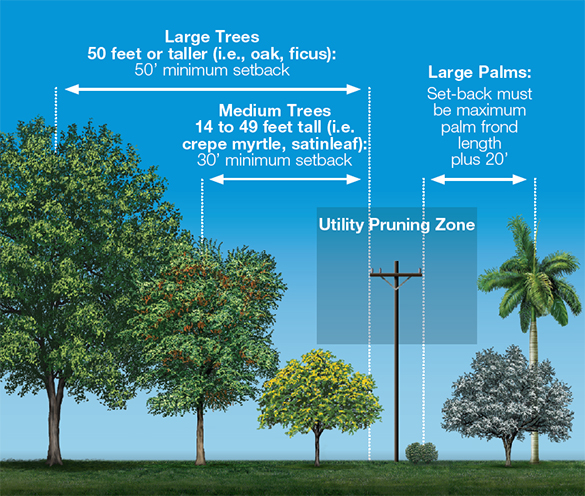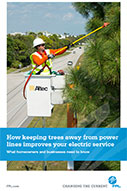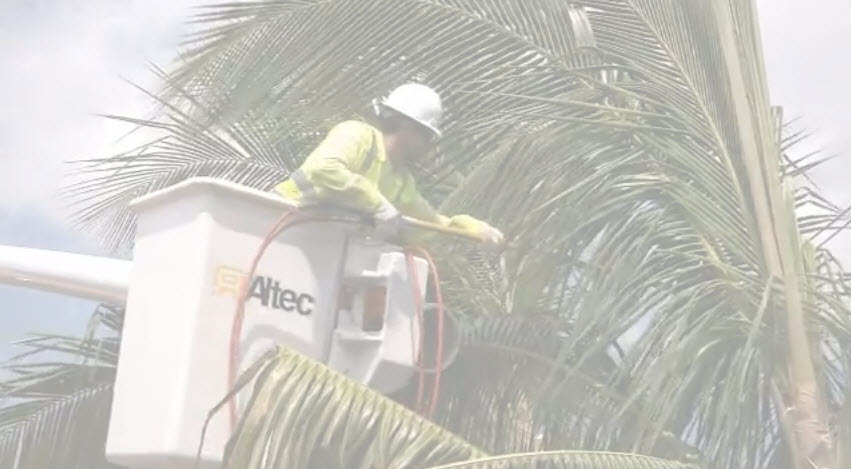Did you know that trees and plants making contact with power lines are among the leading causes of outages? As part of our efforts to provide safe and reliable service for our customers, FPL trims trees and plants from more than 15,000 miles of power lines each year – the equivalent of a round trip from Miami to Tokyo. We are working hard to deliver worry-free energy, now and in the future, and we need your help.
One of the most important things homeowners and businesses can do is follow FPL’s Right Tree/Right Place guidelines. By selecting the right tree and planting in the right place, you can help reduce power outages in your neighborhood.
Here are five simple steps to smart landscaping:
1. Find the Right Tree – Trees come in all shapes and sizes, and often change dramatically over their lifetimes. Some grow tall, some grow wide and some have extensive root systems. Before selecting your tree, make sure you know how tall, wide and deep it will be at maturity. For lists of recommended trees for your region of Florida, please visit the University of Florida’s “Trees and Power Lines” website.
2. Choose the Right Spot – If you’re planting trees on your property, look up and note the location of power lines. Before you plant, keep in mind the setback dimensions in our diagram. Think about how your tree will impact existing utility lines as it grows taller, wider and deeper. Keeping trees away from power lines means that, in the event they blow over or tree limbs become loose, they’re much less likely to hit a power line and knock out power. This also keeps debris farther away from the lines to speed power restoration efforts.

3. Call Before You Dig – If you'll be performing work in your yard that involves digging, Florida law requires you call 811 before you begin to locate and mark buried power lines and other utilities. Call at least two business days before you begin to avoid unintentionally hitting underground utility lines. This fee service helps keep everyone safe. You can also submit your request online at www.Sunshine811.com. |
 |
4. Keep transformers clear – Keep the transformer cabinet (green box often found in front of homes) clear at all times to allow for maintenance and repairs. Maintain a “clear zone” of 8 feet in the front and 3 feet in the back and on both sides.
5. Stay safe around power lines – If you have trees and plants growing near power lines on your property, hire a qualified professional to perform trimming work. Do not take it upon yourself to perform any work near power lines. Whether you're planting a tree, preparing your property for storm season or picking fruit, remember to stay safe and stay far away from power lines at all times.
Always keep yourself and any object you are holding at least 10 feet from main and neighborhood power lines and 30 feet from higher voltage transmission lines. You can be seriously hurt or worse, should you or anything you are touching come into contact with a power line.
 |
Download our "How keeping trees away from power lines improves your electric service" brochure for more smart landscaping tips and information on trimming trees and plants near power lines. |
FPL Tree Facts
FPL operates more than 75,000 miles of overhead power lines.
Trees and plants making contact with power lines are among the leading causes of outages.
Each year FPL trims trees and plants from 15,000 miles of power lines throughout its service area.
FPL’s preventive maintenance plan calls for clearing main power lines every three years and neighborhood lines every six years, on average.
One of the most important things homeowners and businesses can do is follow FPL’s Right Tree/Right Place guidelines. By selecting the right tree and planting in the right place, you can help reduce power outages in your neighborhood.
To protect the health of trees, FPL follows the International Society of Arboriculture and American National Standard Institute pruning guidelines.
